Before we continue let's define two terms, viscosity and flash point.
Viscosity is a measure of how much a liquid resists flowing. i.e. The greater the resistance, the more viscous a substance is.
The flash point of a liquid substance is the lowest temperature at which vapours will ignite when an ignition source is applied, such as a flame.
Below is a table of data of some alkanes. See if you can pick out some trends.
| Name | Flash point oC | Boiling point oC | Melting point oC | Viscosity |
| propane | -104.0 | -42.0 | -188 | 0.080 |
| pentane | - 49.0 | 36.1 | -130 | 0.214 |
| hexane | - 26.0 | 68.0 | -95 | 0.297 |
| heptane | - 4.0 | 98.4 | -91 | 0.376 |
| octane | 13.0 | 126 | -57 | 0.510 |
The key factor that influences, viscosity, flash point, boiling and melting points is the type of intermolecular forces acting between molecules and the strength of these forces. For molecular substances these forces are namely dipole-dipole bonding, hydrogen bonding, van der Walls dispersion forces.
The strength of these forces is determined by the size of the molecule, functional groups present, symmetry of molecular structure and the degree of branching.
With few exceptions the more branching that occurs the lower the melting point of the compound. Take the two structural isomers octane and 2,4-dimethylhexane for example. Both have the molecular mass 114.2 g/mol, however octane has a melting point of -57 oC whereas, the more branched molecule, 2,4-dimethylhexane has a melting point of -110 oC.
One exception is pentane and 2,2-dimethylpropane, the branched, 2,2-dimethylpropane has a higher melting point than pentane.
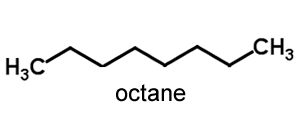
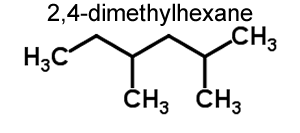
Intermolecular forces such as dipole-dipole bonding , hydrogen bonding and dispersion forces are relatively weak and act over short distances.
Branching does not allow molecules to pack tightly together where the forces can exert their maximum attraction hence it takes less energy to pull apart branched molecules than it does to pull apart linear molecules which pack tightly together.
Lets compare the boiling points of octane and some of its structural isomers.
Octane BP = 125 oC
2-methylheptane BP = 116 oC
2,2-dimethylhexane BP = 107 oC
2,2,4-trimethylpentane BP = 99 oC
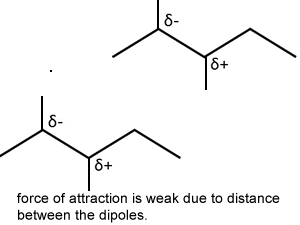
Instantaneous dipoles occur as a result of random movement of electrons within the molecule, the more electrons the more opportunity for instantaneous dipoles to occur.
So even non-polar molecules, such as ethene, can be attracted due to the formation of instantaneous dipoles. A dipole that forms in one molecule induces a dipole in another nearby molecule thus attracting the molecules to each other.
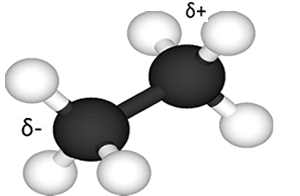
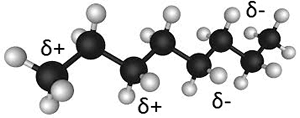
Functional groups are also key to the trends. Consider the table on the right. It clearly shows the impact of the different functional groups on the physical properties of butane. For example, consider the difference a functional group such as carbonyl, hydroxy, and the carboxyl groups make to the melting and boiling temperatures.
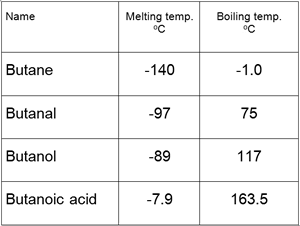
Take ethanoic acid and ethanol as examples. The carboxyl group (COOH), makes the molecule more polar forming stronger hydrogen bonds between molecules.
A hydroxy group, although making the molecule polar does not create hydrogen bonding to the same extent as the carboxyl groups. Ethanoic acid boils at 118 oC whereas ethanol boils at 78.4 oC.
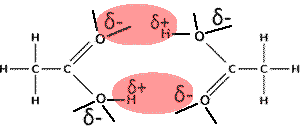
The boiling temperatures of molecules with roughly the same molecular weight are determined by the functional group present on the molecule. Refer to the table on the right.
It is also clear that for molecules with the same functional group, boiling point increases with increase in molecular mass.

Symmetrical molecules only bond by dispersion forces, the weakest of the intermolecular forces. Take pentane for example and its isomer 2,2-dimethylpropane.
Pentane has a boiling point of 36 oC while 2,2-dimethylpropane has a boiling point of 9.0 oC, clearly the forces of attraction between the 2,2-dimethylpropane molecules are weaker than the forces acting between the molecules of pentane.
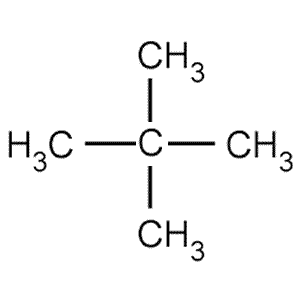
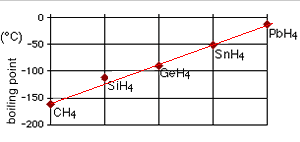
Why?
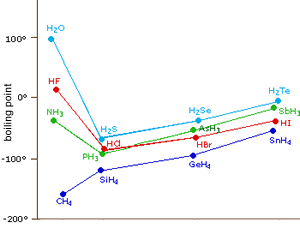
3) Consider the boiling temperatures of the compounds shown on the right. All compounds have the same number of electrons.
i) Which option best describes the reason why pentane has a lower boiling point than butan-1-ol?
ii) Why do the two alcohols differ in boiling temperature?
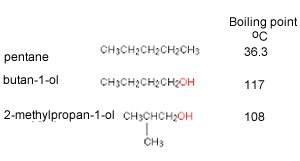
4) Consider the two compounds shown on the right.
i)
Which of the two compounds exhibits the highest boiling temperature? Why.
ii) What are the intermolecular forces acting between ethanol molecules, in order of increasing strength.
iii) What are the intermolecular forces acting between methoxymethane molecules, in order of increasing strength.
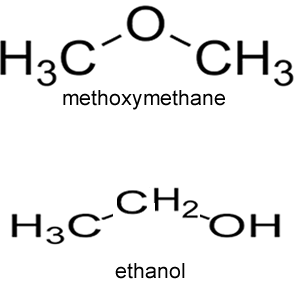
5) Consider the two compounds shown on the right.
i)
Draw the structural formula of each of the molecules.
ii) Which compound has the highest boiling temperature and discuss the reason why?
Solution
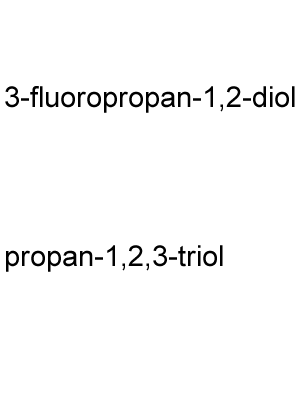
6) Consider the table of shown below of the physical properties of the cis and trans isomers of but-2-ene.
i) Draw the structural formulae of cis-2-butene and trans-2-butene.
| cis-2-butene | trans-2-butene | |
| Melting point | -138.9 oC |
-105.6 oC |
| Boiling point | 3.7 oC |
0.9 oC |
| Density (liquid state) | 0.641 g mL-1 | 0.623 g mL-1 |
ii) Explain, in terms of molecular structural differences and intermolecular bonding, how these differences arise.
7) Explain, using 1,2-dichloroethene as an example why the cis isomer is more soluble than the trans isomer.
Solution
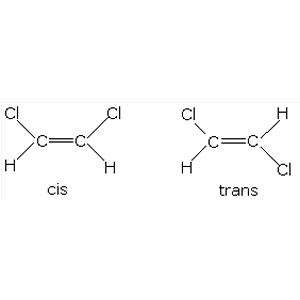
8) Which one of the four compounds listed has the lowest melting point. Explain why
1-decene, 1-octene, cis-2-pentene, 1-pentene
9) Consider the three alcohols shown on the right. Place them in order of increasing boiling point and give reasons.
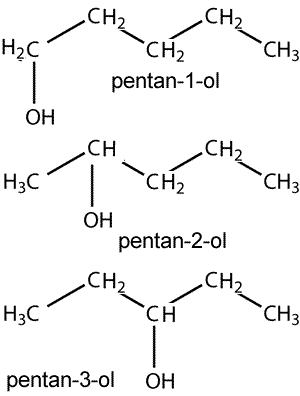
10) Consider the three compounds shown on the right. Place them in order from lowest to highest boiling points. Give reasons.
Solution
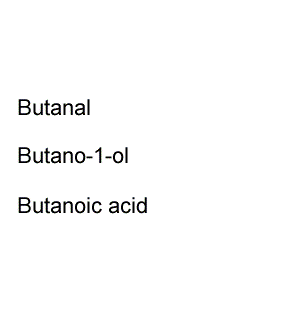
11) Consider the video on the right. It shows an oil being heated.
i. Define the terms flashpoint, flamepoint and autoignition.
ii. Place the following oils in order of increasing flashpoint. Suggest the one that is most dangerous left unattended on the cooktop with a lid on.
a = C17H33COOH
b = C17H31COOH
c = C17H35COOH
iii. Explain your answer to ii. above.
Solution
sourced from https://www.youtube.com/watch?v=suce6QNkVRI 27/06/20 12.07